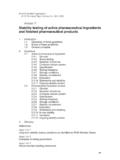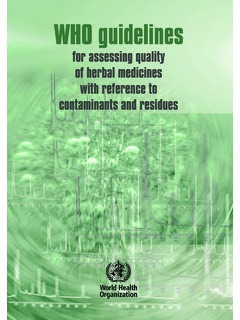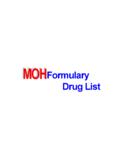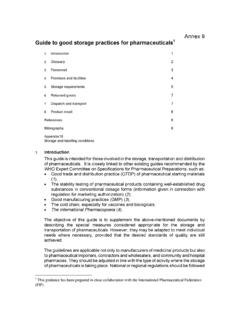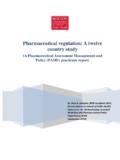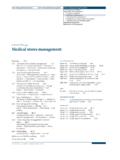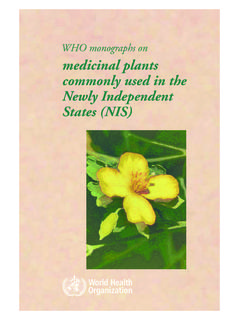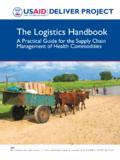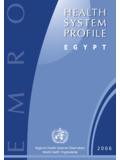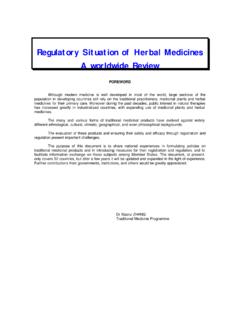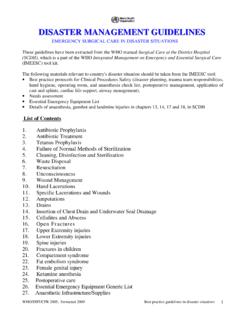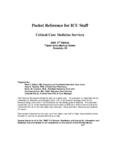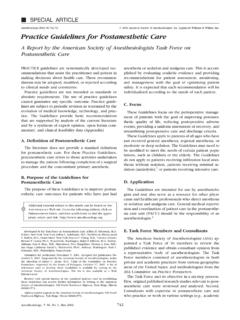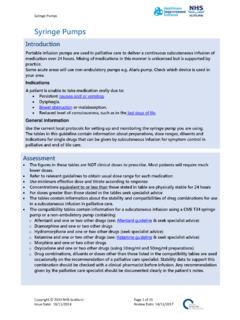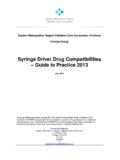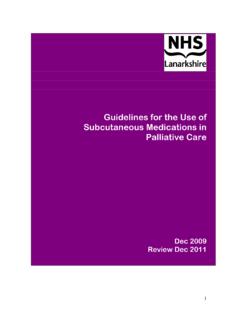Transcription of Emergency Drug Guidelines - WHO
1 Emergency drug Guidelines _____. Second Edition 2008. Ministry of Health Government of Fiji Islands 2008. "This document has been produced with the financial assistance of the European Community and World Health Organization. The views expressed herein are those of the Fiji National Medicine & Therapeutics Committee and can therefore in no way be taken to reflect the official opinion of the European Community and the World Health Organization.. Disclaimer The authors do not warrant the accuracy of the information contained in nd this 2 Edition of the Emergency drug Guidelines and do no take responsibility for any death, loss, damage or injury caused by using the information in these Guidelines . While every effort has been made to ensure that these Guidelines are correct and in accordance with current evidence-based and clinical practices, the dynamic nature of medicine information requires that users exercise in all cases independent professional judgment and understand the individual clinical scenario when referring, prescribing or nd providing information from the Emergency drug Guidelines , 2 Edition.
2 Preface The publication of the Second Edition of the Emergency drug Guidelines represents the culmination of the efforts of the National Drugs and Therapeutics Committee (NDTC) to publish clinical drug Guidelines for common diseases seen in Fiji. These Guidelines are targeted for health care professionals working at hospitals and at the primary health care settings. It sets the gold standard for the use of drugs in the treatment of Emergency medical conditions in Fiji. The Guidelines have taken into account the drugs available in the Fiji Essential Medicines Formulary (EMF), 2006 Edition, in recommending treatment approaches. All recommended therapies are either evidence- based or universally accepted standards. It is hoped that these Guidelines will be used by all health care workers in their daily care of patients suffering from Emergency medical conditions.
3 DR. MARGARET CORNELIUS. Chairperson National Drugs and Therapeutics Committee Ministry of Health, Suva, Fiji 2008. Acknowledgements The First Edition of these Guidelines was drafted on behalf of the Ministry of Health (MOH) by Nick Adams, MBBS (Melb), FACEM, Principal Medical Officer, Accidents and Emergency Department, Colonial War Memorial Hospital in 1999. The Ministry of Health initially approached Dr Adams to prepare these Guidelines as part of an overall effort to develop treatment Guidelines in critical areas. Dr Adams prepared these Guidelines during his employment as a specialist Emergency physician at CWM Hospital. The Ministry of Health gratefully acknowledges the personal enthusiasm and initiative of Dr Adams in producing these Guidelines . Dr Adams was assisted by Elizabeth Pemberton, MBBS, FANZCA, Long-Term Advisor in Anaesthesia, Pacific Postgraduate Medical Centre, Fiji School of Medicine, in the preparation of the draft Guidelines .
4 The Guidelines have been reviewed by a subcommittee of the National Drugs and Therapeutics Committee. Subcommittee on the Preparation of the Second Edition of the Emergency drug Guidelines Dr Gyaneshwar Rao Consultant Physician, Colonial War Memorial Hospital Prof Robert Moulds Clinical Pharmacologist, Professor of Medicine, Fiji School of Medicine Dr Alan Mamerto Garvez Consultant Physician, Colonial War Memorial Hospital Jenney Specialist Physician, Colonial War Memorial Hospital Dr Anne Drake Senior Lecturer in Medicine, Fiji School of Medicine Ms Vasiti Nawadra-Taylor Principal Pharmacist, Fiji Pharmaceutical Services Table of Contents 1 Emergency Drugs 1. Local anaesthetics 1. Sedatives and induction agents 1. Anticholinergics 2. Opiod analgesics 2. Antiemetics 3. Corticosteroids 3. Antiepileptics 3. Antiarrhyhtmics 4. Antihypertensives 5. Inotropic agents 5.
5 Diuretics 6. Muscle relaxants 6. Neuroleptics 6. Anti-asthma drugs 7. Intravenous fluids 7. Tetanus prophylaxis 8. Drugs used in cardiac arrest 8. 2 Cardiovascular Emergencies 10. Cardiac arrest 10. Cardiogenic shock 15. Unstable angina 16. Acute myocardial infarction 17. Cardiac arrhythmias 19. Acute pulmonary oedema 24. Hypertensive Emergency 26. 3 Respiratory Emergencies 27. Asthma 27. Exacerbation of chronic obstructive pulmonary disease 29. Croup 30. Epiglottitis 31. Oxygen therapy 32. 4 Neurologic Emergencies 34. Seizures 34. Migraine 35. Oculogyric crisis 36. Tetanus 36. Acute bacterial meningitis in adults 37. 5 Poisoning and Overdoses 38. General principles 39. Treatment of specific poisons 40. Poisons information 47. 6 Endocrine Emergencies 48. Diabetic ketoacidosis 48. Hyperosmolar, hyperglycaemic state 50. Adrenal insufficiency 50. Hypoglycaemia 51.
6 Thyroid storm 52. Myxydema coma (hypothyroid crisis) 52. Phaeochromocytoma 53. 7 Fluid and Electrolyte Emergencies 54. Hyperkalaemia 54. Hypokalaemia 55. Hypercalcaemia 55. Hypocalcaemia 56. Fluid resuscitation 56. 8 Miscellaneous Emergencies 57. Anaphylaxis 57. Pre-eclampsia 60. Septic shock 61. Acute psychosis 62. Appendix 63. 1 Emergency Drugs This section is intended as a brief guide to some of the drugs mentioned in this book. It is by no means exhaustive and does not cover all contraindications or dosage alterations in special situations. Information about these areas should be obtained elsewhere. The dosages below are guides only. drug therapy should always be adjusted to the individual patient situation. Local Anaesthetics Local anaesthetic agents are used to provide anaesthesia through local wound infiltration, nerve blocks or regional techniques.
7 Side effects from systemic absorption include seizures and cardiac arrhythmias. Avoid accidental intravenous administration by aspirating for blood prior to injection. Lignocaine is the agent of choice for local wound infiltration. The 1% solution is suitable for local infiltration of most wounds. A concentration of 2% should be used for digital nerve blocks and any other area where a smaller volume of anaesthetic is desirable. Lignocaine with adrenaline should not be used on the extremities, nose, fingers, toes, ears or penis. The addition of adrenaline helps control bleeding and also extends the duration of anaesthesia. 1. Sedatives and Induction Agents These drugs are used to depress the conscious state either for sedation or general anaesthesia. They should be used with great care as unconscious patients are unable to protect their airway and because of the risk of causing hypoventilation and hypotension.
8 Ketamine has anaesthetic and analgesic properties and is less likely to produce hypotension than other sedative agents. It also has a mild bronchodilator action which makes it useful when anaesthetising patients with asthma. Adverse effects include increased salivation, laryngospasm, raised intracranial pressure and unpleasant hallucinations after recovery of consciousness. Ketamine should not be used in patients at risk of raised intracranial pressure ( head injuries, meningitis) or in patients with ischaemic heart disease. It should not be given unless personnel and facilities are available to protect the patient's airway. Ketamine should be given as an intravenous bolus. The usual dose is 2 mg per kg although some patients may require larger amounts. The onset of action is within 60 seconds and the duration is about 20 minutes. Thiopentone is a barbiturate with a short action because of rapid distribution.
9 Its main adverse effects relate to cardiorespiratory depression. It should be used with great care in patients who are hypotensive and should not be given unless personnel and facilities are available to protect the patient's 2. airway. It is a potent anticonvulsant and is the drug of choice for anaesthetising patients with status epilepticus. Thiopentone should be given as an intravenous bolus. The usual dose is 3 to 5 mg per kg. The lower dose should be used in the elderly. The onset of action is about 30 seconds and its effects last for 5 to 10 minutes. Midazolam is a short-acting benzodiazepine. It has powerful amnestic properties and produces less cardiorespiratory depression than thiopentone. It is a fairly safe and useful anaesthetic induction agent in the critically ill and is also used to sedate children and agitated patients. Midazolam can be given intramuscularly or as an intravenous bolus.
10 In children, intranasal midazolam is a useful premedication prior to suturing. The onset of action of intravenous midazolam is 1 to 2 minutes and the effects of a single dose last from 60 to 90 minutes. Intranasal midazolam has its maximal effect within 10 minutes and lasts up to 2. hours. In ADULTS: The intravenous dose is to 15 mg. The dose should be titrated to its effect. Smaller doses are usually required for the elderly, whereas alcoholics may require higher doses. The intramuscular dose is 5 to 10 mg. In CHILDREN: The intravenous dose is to mg per kg up to mg per kg. The intranasal dose is to mg per kg (to a maximum of 5 mg), slowly dropped into alternate nostrils 3. over 15 seconds. Anticholinergics Anticholinergic drugs block the effects of acetylcholine at muscarinic receptors. The most commonly used anticholinergic agent is atropine. This drug is used for the treatment of bradycardia due to increased vagal tone, to block the cholinergic effects of drugs such as suxamethonium in children, and to reverse some of the adverse effects of anticholinesterase (organophosphate) poisoning.
